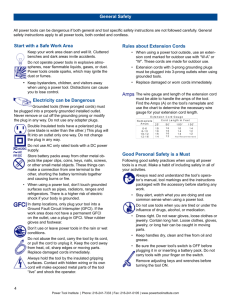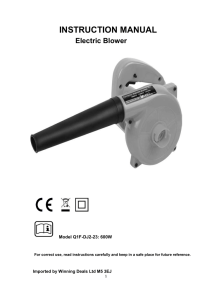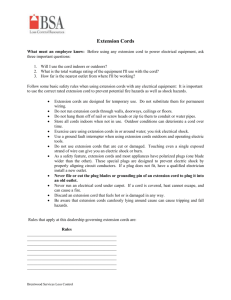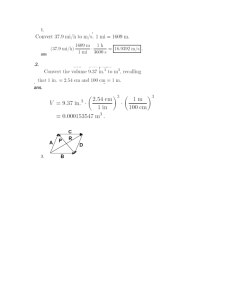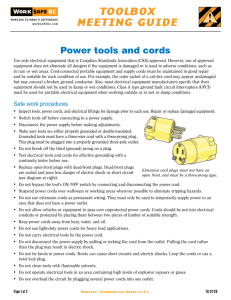October 2015 - Department of Administration
advertisement
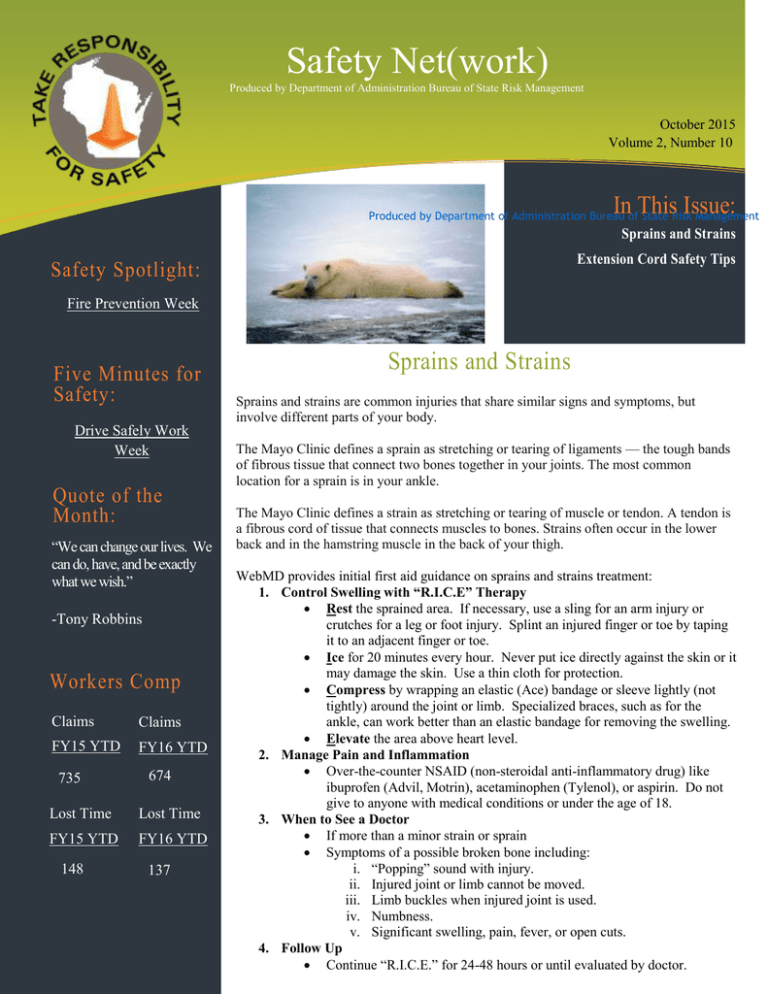
Safety Net(work) Produced by Department of Administration Bureau of State Risk Management October 2015 Volume 2, Number 10 In This Issue: Produced by Department of Administration Bureau of State Risk Management Sprains and Strains Extension Cord Safety Tips Safety Spotlight: Fire Prevention Week Five Minutes for Safety: Drive Safely Work Week Quote of the Month: “We can change our lives. We can do, have, and be exactly what we wish.” -Tony Robbins Workers Comp Claims Claims FY15 YTD YTD 735 FY16 YTD Lost Time Lost Time FY15 YTD FY16 YTD 148 674 137 ` Sprains and Strains Sprains and strains are common injuries that share similar signs and symptoms, but involve different parts of your body. The Mayo Clinic defines a sprain as stretching or tearing of ligaments — the tough bands of fibrous tissue that connect two bones together in your joints. The most common location for a sprain is in your ankle. The Mayo Clinic defines a strain as stretching or tearing of muscle or tendon. A tendon is a fibrous cord of tissue that connects muscles to bones. Strains often occur in the lower back and in the hamstring muscle in the back of your thigh. WebMD provides initial first aid guidance on sprains and strains treatment: 1. Control Swelling with “R.I.C.E” Therapy Rest the sprained area. If necessary, use a sling for an arm injury or crutches for a leg or foot injury. Splint an injured finger or toe by taping it to an adjacent finger or toe. Ice for 20 minutes every hour. Never put ice directly against the skin or it may damage the skin. Use a thin cloth for protection. Compress by wrapping an elastic (Ace) bandage or sleeve lightly (not tightly) around the joint or limb. Specialized braces, such as for the ankle, can work better than an elastic bandage for removing the swelling. Elevate the area above heart level. 2. Manage Pain and Inflammation Over-the-counter NSAID (non-steroidal anti-inflammatory drug) like ibuprofen (Advil, Motrin), acetaminophen (Tylenol), or aspirin. Do not give to anyone with medical conditions or under the age of 18. 3. When to See a Doctor If more than a minor strain or sprain Symptoms of a possible broken bone including: i. “Popping” sound with injury. ii. Injured joint or limb cannot be moved. iii. Limb buckles when injured joint is used. iv. Numbness. v. Significant swelling, pain, fever, or open cuts. 4. Follow Up Continue “R.I.C.E.” for 24-48 hours or until evaluated by doctor. Extension Cord Safety Tips Consumer Safety United States Consumer Product Safety Commission Contact Us http://www.doa.state.wi.us E-Mail Jake.Lowell@Wisconsin.gov ` According to the U.S. Consumer Product Safety Commission, an estimated 4,000 people are treated in emergency rooms each year due to injury working with extension cords. Half of the injuries involve fractures, lacerations, contusions, or sprains from people tripping over extension cords. Approximately 3,300 residential fires start with extension cords each year, fatally injuring 50 people and injuring 270 others. The most frequent causes are short-circuits, overloading, damage, and/or misuse of extension cords. In a recent Public Entity Publication, Arthur J. Gallagher & Co. provides several Do’s and Don’ts to help prevent extension cord accidents: If an extension cord is not marked for outdoor use, only use it indoors. The Underwriters Laboratories (UL) label will tell you if it is okay for outdoor use. Inspect the cord before you use it. Look for areas that are cracked or frayed. If you find any, dispose of the cord. Don’t run extension cords through doorways, or through holes in ceilings, walls or floors. The appliance or tool that you are using the cord with will have a wattage rating on it. Match this up with your extension cord. Don’t use a cord that has a lower rating. Make sure the appliance or tool is off before you plug it into the cord. Make sure the plug is fully inserted in the outlet. Don’t remove, bend or modify any of the metal parts of the cord’s plug. Don’t plug a three-prong plug into a two-hole cord. You shouldn’t have to force a plug into an outlet. If the plug is too loose in the outlet, the outlet may be too old and need to be replaced. Some cords are polarized; one prong on the plug is larger than the other. Match up the outlet and the cord. Keep the extension cord away from water; don’t use it when it is wet. Keep it away from children and pets. Don’t plug one extension cord into another. Don’t overheat the cord. Uncoil it, and don’t cover it with anything. Don’t drive over the cord. Don’t drag it or lay anything on it. Don’t walk on it. After use, remove it from the outlet by pulling on the plug, not the cord. Store it indoors.
